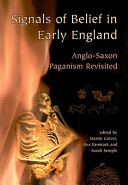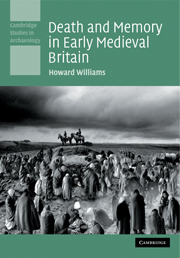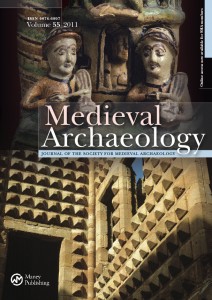
Sir Cyril Fred Fox was an English archaeologist and museum director.

Rupert Leo Scott Bruce-Mitford, FBA, FSA was a British archaeologist and scholar. He spent the majority of his career at the British Museum, primarily as the Keeper of the Department of British and Medieval Antiquities, and was particularly known for his work on the Sutton Hoo ship-burial. Considered the "spiritus rector" of such research, he oversaw the production of the monumental three-volume work The Sutton Hoo Ship-Burial, termed by the president of the Society of Antiquaries as "one of the great books of the century".
Roberta Lynn Gilchrist, FSA, FBA is a Canadian-born archaeologist and academic specialising in the medieval period, whose career has been spent in the United Kingdom. She is Professor of Archaeology and Dean of Research at the University of Reading.

Martin Rundkvist is a Swedish archaeologist and associate professor at the University of Łódź in Poland. His research focuses on the Bronze, Iron, and Middle Ages of Scandinavia, including significant excavations in the province of Östergötland.

The Cambrian Archaeological Association was founded in 1846 to examine, preserve and illustrate the ancient monuments and remains of the history, language, manners, customs, arts and industries of Wales and the Welsh Marches and to educate the public in such matters. The association's activities include sponsoring lectures, field visits, and study tours; as well as publishing its journal, Archaeologia Cambrensis, and monographs. It also provides grants to support research and publications.

The Taplow Barrow is an early medieval burial mound in Taplow Court, an estate in the south-eastern English county of Buckinghamshire. Constructed in the seventh century, when the region was part of an Anglo-Saxon kingdom, it contained the remains of a deceased individual and their grave goods, now mostly in the British Museum. It is often referred to in archaeology as the Taplow burial.

Offa is a community and electoral ward in Wrexham County Borough, Wales, covering most of the south-western portion of the city of Wrexham. It is bordered by the communities of; Rhosddu, and Caia Park to the north, Abenbury to the east, Esclusham, and Marchwiel to the south, and Broughton, Coedpoeth, and Gwersyllt to the west.

Michael James Swanton is a British historian, linguist, archaeologist and literary critic, specialising in the Anglo-Saxon period and its Old English literature.

Signals of Belief in Early England: Anglo-Saxon Paganism Revisited is an academic anthology edited by the British archaeologists Martin Carver, Alex Sanmark and Sarah Semple which was first published by Oxbow Books in 2010. Containing nine separate papers produced by various scholars working in the fields of Anglo-Saxon archaeology and Anglo-Saxon history, the book presents a number of new perspectives on Anglo-Saxon paganism and, to a lesser extent, early Anglo-Saxon Christianity. The collection – published in honour of the archaeologist Audrey Meaney – was put together on the basis of a conference on "Paganism and Popular Practice" held at the University of Oxford in 2005.

Death and Memory in Early Medieval Britain is an archaeological study of mnemonic elements in the funerary practices of Early Medieval Britain, written by the British archaeologist Howard Williams. The book was first published by Cambridge University Press as part of their series "Cambridge Studies in Archaeology" in 2006.

Medieval Archaeology is an annual peer-reviewed academic journal covering the archaeology of the medieval period, especially in the United Kingdom and Ireland. It was established in 1957 by the Society for Medieval Archaeology and is published on their behalf by Taylor & Francis. The editor-in-chief is Aleks McClain.
Julian Daryl Richards is a British archaeologist and academic. He works at the University of York, and is director of the Archaeology Data Service (ADS), and Internet Archaeology. He is also the director of the Centre for Digital Heritage at the university, and contributed to the founding of The White Rose College of the Arts & Humanities. His work focuses on the archaeological applications of information technology. He has participated in excavations at Cottam, Cowlam, Burdale, Wharram Percy, and Heath Wood barrow cemetery.

Sonia Chadwick Hawkes, was a leading specialist in early Anglo-Saxon archaeology, described by fellow medieval archaeologist Paul Ashbee as a "discerning systematiser of the great array of Anglo-Saxon grave furnishings". She led major excavations on Anglo-Saxon cemeteries at Finglesham in Kent and Worthy Park in Hampshire.
Tania Marguerite Dickinson is a British archaeologist specialising in early-medieval Britain. Dickinson undertook undergraduate study at St. Anne's College, Oxford and postgraduate study at the Institute of Archaeology (Oxford). Her doctoral thesis, titled The Anglo-Saxon burial sites of the upper Thames region, and their bearing on the history of Wessex, circa AD 400-700, was supervised by Sonia Chadwick Hawkes and Christopher Hawkes.
Dawn Marie Hadley is a British historian and archaeologist, who is best known for her research on the Anglo-Saxon and Viking-Age periods, the study of childhood, and gender in medieval England. She is a member of the Centre for Medieval Studies and the department of archaeology at the University of York.
John Bradley was a historian and archaeologist at NUI Maynooth. He grew up in Kilkenny and published many papers about his hometown.
Dr Ruth Shaffrey is an archaeologist.
Quita Mould is an archaeologist, specialising in small finds and the identification of leather.
Griffin Murray is an Irish archaeologist and art historian specialising in medieval Ireland and Insular art–especially metalwork–in the period between 400–1550 AD. His interests include identifying and contextualizing the social role of medieval craftsmen, Viking art and the relations between insular and Scandinavian craftsmen, and he is a leading expert on both house-shaped shrines and insular croziers.
Rachel Swallow is an archaeologist specialising in the study of landscapes and castles. She was elected a Fellow of the Society of Antiquaries of London in 2018. Swallow studied at Birmingham Polytechnic and the University of Liverpool before completing a PhD at the University of Chester in 2015. She is visiting research fellow and guest lecturer at the University of Chester and honorary fellow at the University of Liverpool.











